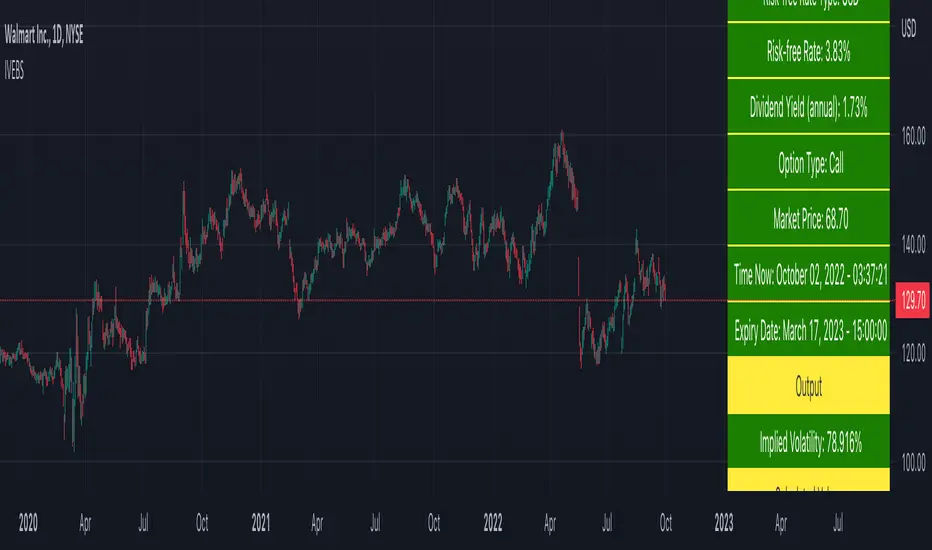OPEN-SOURCE SCRIPT
Implied Volatility Estimator using Black Scholes [Loxx]

Implied Volatility Estimator using Black Scholes [Loxx] derives a estimation of implied volatility using the Black Scholes options pricing model. The Bisection algorithm is used for our purposes here. This includes the ability to adjust for dividends.
Implied Volatility
The implied volatility (IV) of an option contract is that value of the volatility of the underlying instrument which, when input in an option pricing model (such as Black–Scholes), will return a theoretical value equal to the current market price of that option. The VIX , in contrast, is a model-free estimate of Implied Volatility. The latter is viewed as being important because it represents a measure of risk for the underlying asset. Elevated Implied Volatility suggests that risks to underlying are also elevated. Ordinarily, to estimate implied volatility we rely upon Black-Scholes (1973). This implies that we are prepared to accept the assumptions of Black Scholes (1973).
Inputs
*** the algorithm inputs for low and high aren't to be changed unless you're working through the mathematics of how Bisection works.
Included
Related Indicators
Cox-Ross-Rubinstein Binomial Tree Options Pricing Model [Loxx]
![Cox-Ross-Rubinstein Binomial Tree Options Pricing Model [Loxx]](https://s3.tradingview.com/h/hw252XKE_mid.png)
Implied Volatility
The implied volatility (IV) of an option contract is that value of the volatility of the underlying instrument which, when input in an option pricing model (such as Black–Scholes), will return a theoretical value equal to the current market price of that option. The VIX , in contrast, is a model-free estimate of Implied Volatility. The latter is viewed as being important because it represents a measure of risk for the underlying asset. Elevated Implied Volatility suggests that risks to underlying are also elevated. Ordinarily, to estimate implied volatility we rely upon Black-Scholes (1973). This implies that we are prepared to accept the assumptions of Black Scholes (1973).
Inputs
- Spot price: select from 33 different types of price inputs
- Strike Price: the strike price of the option you're wishing to model
- Market Price: this is the market price of the option; choose, last, bid, or ask to see different results
- Historical Volatility Period: the input period for historical volatility ; historical volatility isn't used in the Bisection algo, this is to serve as a comparison, even though historical volatility is from price movement of the underlying asset where as implied volatility is the volatility of the option
- Historical Volatility Type: choose from various types of implied volatility , search my indicators for details on each of these
- Option Base Currency: this is to calculate the risk-free rate, this is used if you wish to automatically calculate the risk-free rate instead of using the manual input. this uses the 10 year bold yield of the corresponding country
- % Manual Risk-free Rate: here you can manually enter the risk-free rate
- Use manual input for Risk-free Rate? : choose manual or automatic for risk-free rate
- % Manual Yearly Dividend Yield: here you can manually enter the yearly dividend yield
- Adjust for Dividends?: choose if you even want to use use dividends
- Automatically Calculate Yearly Dividend Yield? choose if you want to use automatic vs manual dividend yield calculation
- Time Now Type: choose how you want to calculate time right now, see the tool tip
- Days in Year: choose how many days in the year, 365 for all days, 252 for trading days, etc
- Hours Per Day: how many hours per day? 24, 8 working hours, or 6.5 trading hours
- Expiry date settings: here you can specify the exact time the option expires
*** the algorithm inputs for low and high aren't to be changed unless you're working through the mathematics of how Bisection works.
Included
- Option pricing panel
- Loxx's Expanded Source Types
Related Indicators
Cox-Ross-Rubinstein Binomial Tree Options Pricing Model [Loxx]
![Cox-Ross-Rubinstein Binomial Tree Options Pricing Model [Loxx]](https://s3.tradingview.com/h/hw252XKE_mid.png)
Release Notes
Updated volatility calculations. Release Notes
Corrected dividend calculation. Open-source script
In true TradingView spirit, the author of this script has published it open-source, so traders can understand and verify it. Cheers to the author! You may use it for free, but reuse of this code in publication is governed by House rules. You can favorite it to use it on a chart.
Public Telegram Group, t.me/algxtrading_public
VIP Membership Info: patreon.com/algxtrading/membership
VIP Membership Info: patreon.com/algxtrading/membership
Disclaimer
The information and publications are not meant to be, and do not constitute, financial, investment, trading, or other types of advice or recommendations supplied or endorsed by TradingView. Read more in the Terms of Use.